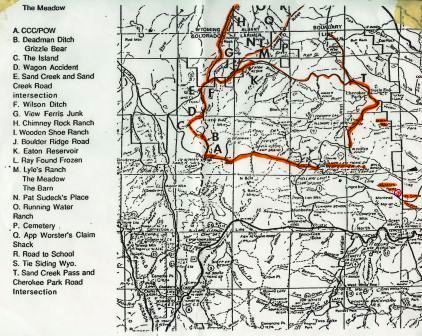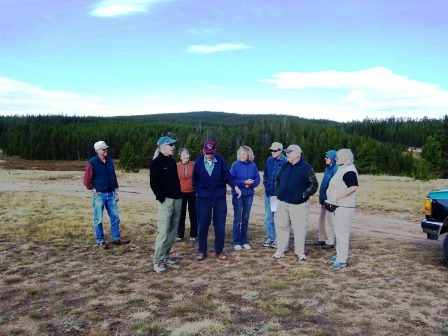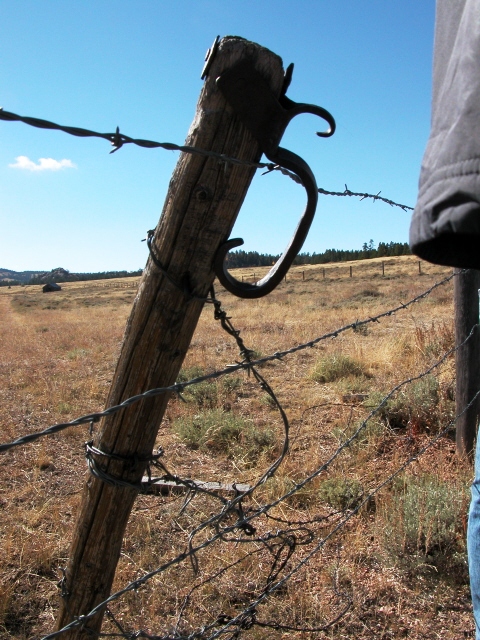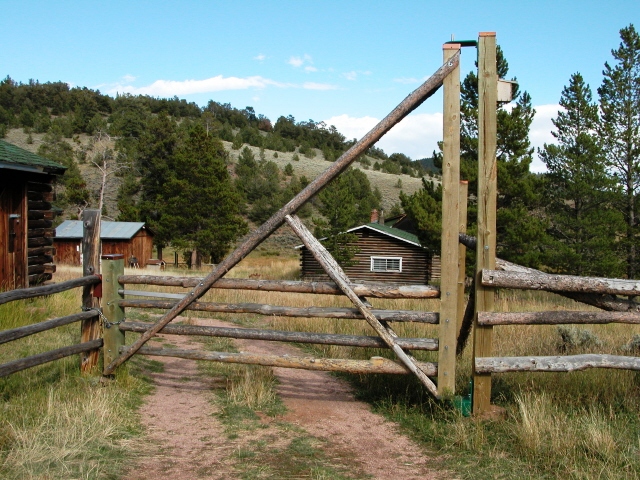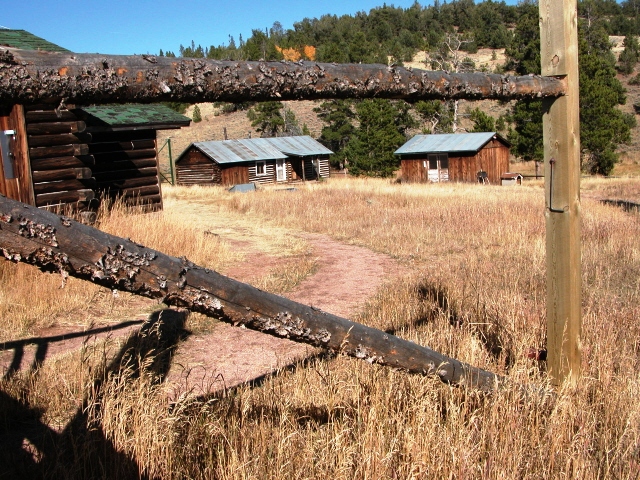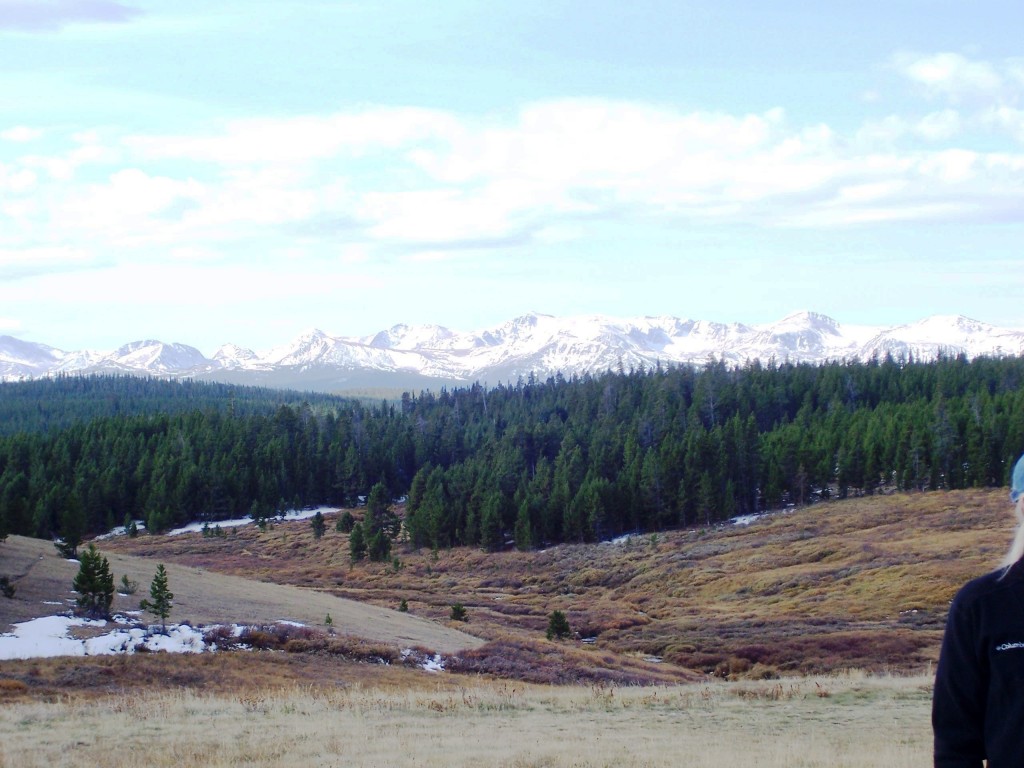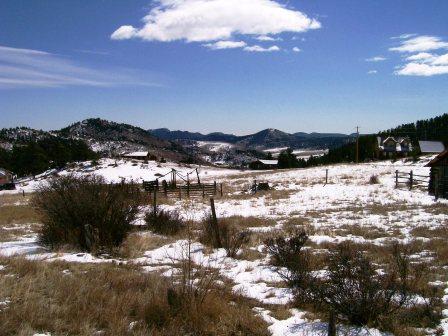Dennis Frydendall “Meadow” Tour Interview
October 7, 2008, at his son David’s home in Fort Collins
Interview and transcription by Linda Bell
[Interview available as PDF file]
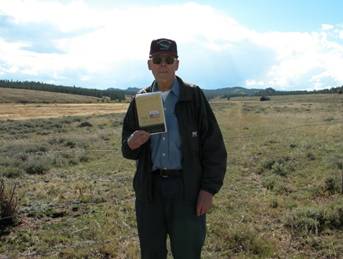
Table of Contents
- An Idea for a Trip
- The Tour
- The “Meadow” and the Reservoir
- Over Boulder Ridge
- Stories from the Road
- About the Book
- Map and Photos of 2006 Tour
The Meadow, the book by James Galvin, was recommended to me by Maryanne Lyon. Marianne read it the year it was published (1992) and passed it on to me. I have no idea why…. But anyway, I enjoyed the book and passed it on to Nelson Denney and he read it, and out of that discussion about the book, we went to scope out the area and find out more about the meadow itself and particularly Lyle Van Waning’s place.
We spent a Saturday morning, starting out by going over Cherokee Park Road, stopping at the old Homestead house (Store) or whatever it is, and talked to (Red) Ashby who didn’t know much about it. We then proceeded up to the Sheep Creek drainage knowing eventually we’d get to the Eaton Reservoir, which plays a prominent part in the book.
That trip we talked to Toya Wilkes, whose husband was Ed Wilkes and he was the manager of the Eaton Reservoir. He replaced Ray Worster after he died. The Wilkes’ were interesting people because they had come from Florida and had bought one of the 35 acres, as Jim called them, part of the “trailer trash.” They were involved with Lyle and also Jim to a great extent, more than anybody in that area that survived until the time I got involved in it. They told us several things about it. You can read the book and reconfirm some of the things that were particularly interesting like about the square pancakes, and feeding the birds, and Lyle’s temperament. Ed said when he’d call in to see Lyle. He’d kind of stand up until he kind of decided if Lyle was in a mood that would bare conversation or whether it would be a good thing to turn around and leave him. Anyway, Ed had Lyle over to dinner and those kinds of neighborhood things.
Toya pointed out all the things we needed to know in terms of the property layouts from the Van Waning property to where it joined the Galvins’ property and where the Galvin property joins the 20,000 acre Chimney Rock Ranch sold off to 35 acre developments.
We already had a pretty good idea about how the water system worked to feed the reservoir, although I had never been to the dam and the impoundment before. You can see traces of it from various locations without actually getting there. And of course, as you go toward Chimney Rock and into Wyoming to the Wooden Shoe Ranch, it became obvious that this would be a good place to go on a trip, and take people.
From that point, we sort of developed an itinerary which would take us over Deadman and down Sand Creek Road, which is kind of a jeep road. More so at that time than it is at present. We added some extra things in there that took a little more time and gave people a chance to talk and drink coffee and what have you.
In order to really appreciate the trip, you have to read the book. Each of these places we would stop would have some connection with the Meadow itself or an incident described as being about “here” or in my estimation, in this area. It also had a – oh, sort of an adventure element to it so that people who had 4-wheel drives and wanted, could get out into the woods and try them out. We’d manage to start out from Red Feather about nine o’clock in the morning, go over Deadman, stop at Deadman Creek for a view of the area described by Jim in the book as being this “island concept” that mystified many people. It also gives you a chance to introduce Jim as a poet writing a novel, and poets kind of have a way of turning the language into things that are beautiful rather than mundane.
We proceed on into the north country, down towards Wyoming. We stopped at the Parshall flume that measures water out of Deadman Creek and dumps it into Sand Creek, which is a tributary back into the Laramie River. On down below, the water can be diverted out of Sand Creek into Sheep Creek which is a tributary to the Poudre System and the South Platte. In the process of doing this, you have opportunities to see the various high parts of the area closest to Red Feather, the Deadman area. You get to see some wildlife – moose and deer and what have you.
We liked to do it in the fall for a couple of reasons. It is leaf time and there are some beautiful aspen particularly over in the Sand Creek drainage that is just special at that time of year. And weather-wise, the fall is probably the best time of year to go out and about. It’s cooled off enough so that once you get off the pavement, about a mile out of Red Feather, the dust is not so hard to put up with.
As we proceed along the Sand Creek Road we stop at a spot where we have lunch, always in the same place. It’s a place with a beautiful view of Bull Mountain. Sometimes there are bow hunters out at this time of year, but they can see us pretty well.
Originally this tour was sponsored by the Friends of the Library. Then they sort of lost interest and got into some other things, so then the Historical Society sponsored it. It’s always been a cheap trip…. Well, the people who go furnish their own food and transportation for the most part.
After our lunch stop we get into a completely different geological area as we go north to Chimney Rock and into Wyoming. The geological formations are just absolutely opposite of what we’ve previously been in all morning. We go into Wyoming to observe some interesting formations of sandstone, limestone, wind-driven sculptures in rock that are just amazing. It is a fun place to go. The birds are entirely different, and even the wildlife. You get down into that area and there are antelope, coyotes, and even badgers. It’s just entirely different.
Our first stop is the entrance to the Chimney Rock Ranch just below the Chimney Rock formation in Wyoming, the setting for some of the scenes in The Meadow. You proceed on north to Wooden Shoe Ranch where the area mail boxes are located.
You look at Oscar Marsh’s Wooden Shoe Ranch and they built – or didn’t build – classy houses. But most of those ranches were hand to mouth operations. The old buildings all looked pretty much alike. The buildings at Chimney Rock Ranch are all newer buildings and not the original 1800s buildings.
On our return to Boulder Ridge our first stop is the Wurl Ranch. It’s my understanding that the old guy was a mason and if you look at the rocks around the place…. He lived there and as you go back up into Colorado there’s another old building that’s now pretty well gone that was also part of the Wurl Ranch. I think he owned a good deal of land in there at one time, it was obviously swallowed up by the Chimney rock Ranch as it expanded, but what happened and why, I have no idea. The house looks a bit like a castle.
Back in Colorado I do point out the Harris’s junk yard on the tour. All I know is that Mother Nature or somebody that owned the land – you see, he put all this stuff on somebody else’s ground to begin with. He thought it was his, or seemingly thought it was his…. When it came down to it, and all the animosities flared up, it wasn’t on his ground and he wasn’t responsible for it. It lay there for several years and you could see it with field glasses from the road. You could see refrigerators, washing machines. I can’t find any trace of it now from my vantage point where I could see it before. The answer to the question is; it may have been removed physically, or somebody may have gone up there with a backhoe and dug a hole and buried it all, I don’t know.
The “Meadow” and the Reservoir
From Boulder Ridge I point out the Eaton Reservoir – Eaton Reservoir is as described in the book as the upper half of the hourglass which App Worster describes the meadow to have been. It’s very obvious that right where the dam is, the whole upper half kind of squeezes together and here’s this seemingly tall dam with a rather short span. You think of dams as being big, long, and this one is very short, very confined….
Then Lyle Van Waning’s place sits there overlooking the lower half of the hourglass. Over the years since I’ve been going there some things have changed. Some of the posts have been replaced. Somebody’s put some very fancy metal – copper – caps on some of the new poles. Some of the gates that were just old and Lyle’s handiwork have been replaced. They were wearing out, I’m sure. But the buildings themselves … one of the main buildings, they obviously put a new double door on it that is different than when I first went, but the house, or basically what you see, has changed very little. The old App Worster barn is sort of unobservable from outside the fence, which kind of limits people to stay out of the yard and what not, but according to that Gully (Gully is the present owner of the property) e-mail it’s partly blown over during the last year or so. Jim Galvin had described it rotting away and sinking one log at a time. When I first went up there I climbed the fence and actually saw the thing, and that was a very apt description of the process. Of course Jim was comparing Lyle’s obsession with foundations to App’s not being obsessed with them at all.
I have no idea what the (Gullys’) long term intent is. The reality is the ranching business at that elevation is unprofitable. If they need the money, the only way to make money is to subdivide. If they can afford to keep it for recreation, fine.
In the time I’ve observed (the property) it’s been through two or three ownerships. I think the first one was a cattle operation that didn’t work out. Then there was a couple and a single person who bought it and had half a dozen horses, which is a big pasture for half a dozen horses. But there are so many interesting things about the property itself, the things that people have done there to make it livable and workable. I don’t understand, and likely never will understand, why there are so many buildings in such a confined space and what their usages were. You can imagine some of them as being a place where you would unload a load of feed, but it is just dotted with these little buildings. I finally concluded that Lyle just liked to build and when he had a stack of material he’d put up a building. They all had good foundations!
He had a shop and the person who showed me which building the shop was in – and it was in half of the building and the other half they lived in, I think – he and his brother…. Jim describes it as being so small that a person could hardly turn around in it without bumping into things.
The trip goes on over to where you can see down into Wyoming and the place where (Lyle) parked his truck over the winter so he could get out and go to Laramie and haul his groceries or whatever back to the cabin. The road between the two would be impossible during the hard part of the winter. Then as we exit the whole meadow area we take the Boulder Ridge Road leading back toward to Tie Siding, where the Worster boys went to school, when they went to school, which wasn’t often or long. We visit the graveyard as kind of the last site on the trip – and it’s always hard to find the graveyard. I know where it is, I’ve been there time after time, and yet it’s hidden.
Then we finally come back to the Prairie Divide Road, although people often times go over to 287 and go back that way, especially people who live down in Fort Collins. I always go the back way, back to Red Feather, because I just like that trip. The aspen down there are not nearly as turned yet as up on Sand Creek pass, which is where they are really out. When it is pretty, it is about as pretty a place as you can find.
One year we had a cold, cloudy day – a good brisk wind blowing on us – and we had a woman on the trip who lived just across the road from The Forks. Elizabeth Smith, I think. She was quite elderly and she wanted to take the trip. Well, we got up to the old burn where we look out on the Laramie River and Four Corners, and she unzipped her windbreaker, a little old thin nylon windbreaker, opened it up and said; “Wyoming wind – I love it!” Well, come to find out, she and her husband had ranched at the Antelope Springs, or the Antelope something Ranch, just west of Oscar and Joella Marsh at and the Wooden Shoe Ranch. They’d been neighbors for 15-20 years. So we went down there and she wanted to go see Joella. Of course Joella – when we had these trips we stay away from bothering people because there’s 15-20 people showing up at their door and they don’t know if it’s a raid or what – but anyway, she went to the door and Joella came out and they hugged and talked and talked and talked. I didn’t find out a whole lot, but they actually did in fact know each other. It was fine weather with her, I’ll tell `ya. I don’t think I had anyone enjoy the trip as much as Mrs. Smith, even though she had just fallen off her horse a few days before and her kids were worrying about it.
Another woman, much younger, told how she used to come to the Wooden Shoe Ranch as a teenager when it functioned as a guest ranch. She came from Chicago. She told how she remembered playing hide and seek among the rock formations in the area on horseback. Her memories explain all the little buildings at the Wooden Shoe Ranch.
The thing I particularly liked about the book was that it was basically a love affair between Jim and that area. It’s something that people lose. If you lived in Fort Collins all your life, the house, or you’d live in two or three houses, but you’d never have that guide to see that house torn down or built up, that vacant lot not vacant, but up there the impact of 20,000 acres suddenly collapsing, we have an emotional chart that I think he described very well.
I’ve read both (of Galvin’s books). Fencing the Sky is sort of like most books that follow – kind of like the second movie. The sequels are always lacking. I enjoyed the book and if you separate out the bitterness a little bit it’s readable and enjoyable. But The Meadow is much superior. I heard Jim speak at the Writers’ Workshop in Greeley. I missed him when he spoke in Loveland. You don’t get much from talking to him, I’ll tell you. If you want to talk to Jim, read what he writes.
I could never work in the Sheep Creek part of the story because the days are only so long. We could add a swing down to Sheep Creek where the Japanese were fishing and Worster was stuck in that storm, and when App and the boys were coming from Fort Collins and Jack kept on lying down and old App would kick him and beat on him to save his life. He’s meaner than a junk-yard dog in the process and finally he finds some shelter with packrats’ nests and they started a fire with the packrat stuff and warmed up. When the blizzard blew over, why, they were looking right down on the cabin there. But they hadn’t known where they were.
Whether the book is “creative non-fiction” is an argument everyone wants to get into and it’s like a dog chasing its tail. I think it’s obvious to me that Jim is very protective of the Van Waning family, beyond reality. He tries to make it look different than it really is, and in that sense it is fiction. You can’t write very realistically about people you are so entangled with, there is always the emotional, especially when you’re young. But even as an adult, if you’re really close to somebody it’s hard to point out the warts.
Map and Photos of 2006 Tour
Map created by Dennis Frydendall, photos by Judd Adams
